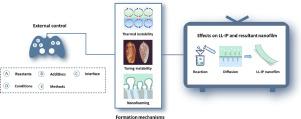Progress in Polymer Science ( IF 26.0 ) Pub Date : 2021-09-06 , DOI: 10.1016/j.progpolymsci.2021.101450 Zhuyuan Wang 1 , Songmiao Liang 2 , Yuan Kang 1 , Wang Zhao 1 , Yun Xia 1 , Jindi Yang 1 , Huanting Wang 1 , Xiwang Zhang 1

|
Composite separation membranes are essential in the fields of water treatment, mass concentration, purification, solvent exchange, gas separation, energy storage and conversion. The ability of composite membranes to selectively transport water, ions, solvents and other species is derived from their active layers with excellent selectivity, which are ultrathin polymeric nanofilms on supporting substrates. Hence, the fabrication and manipulation of the selective nanofilms have been of a great interest for decades. Liquid to liquid interfacial polymerization (LL-IP) has been maintaining its dominance in synthesizing high-quality polymeric nanofilms. Nonetheless, some ambiguities still remain in this industrial friendly reel-to-reel process owing to reaction complexity, limiting its capability of precise controlling on physicochemical properties of resultant nanofilms, which are highly desired in many applications. In this review, we delve into this powerful yet intangible technique from physics, chemistry and material perspectives. To lay a groundwork for controlling structure and chemical properties of nanofilms, this review focuses on the effects of the intrinsic chemistry and extrinsic environment of LL-IP process. The corresponding mechanisms and fundamental principles are discussed by linking up relevant studies. In addition, the molecular-sieving performance of nanofilms synthesized under various conditions is briefly reviewed to help readers appreciate the correlation between structure, properties and performance. The existing challenges to be addressed are consequently identified and the future research directions are discussed accordingly.
中文翻译:

控制复合分离膜聚合物纳米膜的界面聚合
复合分离膜在水处理、质量浓缩、净化、溶剂交换、气体分离、能量储存和转化等领域必不可少。复合膜选择性传输水、离子、溶剂和其他物质的能力源自其具有优异选择性的活性层,这些活性层是支撑基材上的超薄聚合物纳米膜。因此,几十年来,选择性纳米膜的制造和操作一直备受关注。液对液界面聚合(LL-IP)在合成高质量聚合物纳米膜方面一直保持着主导地位。尽管如此,由于反应的复杂性,在这种工业友好的卷对卷过程中仍然存在一些歧义,限制其精确控制所得纳米膜的物理化学性质的能力,这在许多应用中是非常需要的。在这篇综述中,我们从物理、化学和材料的角度深入研究了这种强大而无形的技术。为了为控制纳米膜的结构和化学性质奠定基础,本综述重点关注 LL-IP 过程的内在化学和外在环境的影响。结合相关研究讨论了相应的机制和基本原理。此外,简要回顾了在各种条件下合成的纳米薄膜的分子筛分性能,以帮助读者了解结构、性能和性能之间的相关性。











































 京公网安备 11010802027423号
京公网安备 11010802027423号